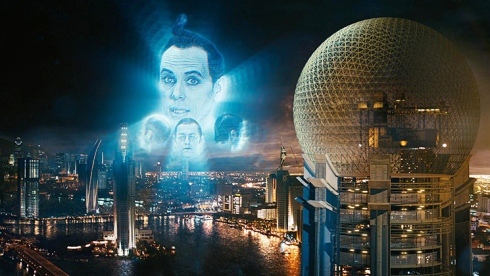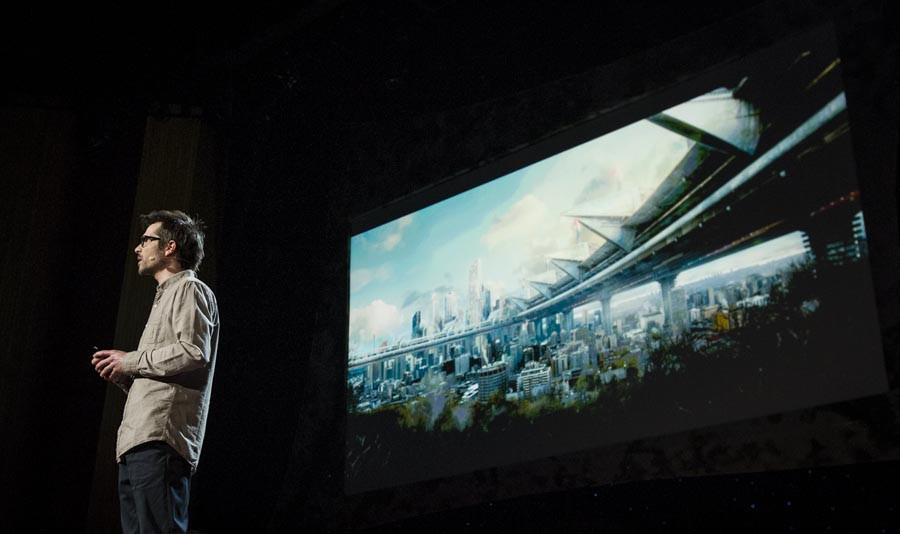Below is a snippet of some of my favorite sensory memories on the TED 2013 stage in Long Beach, California last week. From film production, art, photography, graphic design, technology and abundance to innovation, special effects and the power of the combination of all five of our senses to infuse more awareness and passion into our lives, Martin Villeneuve, Andrew McAfee, Barb Stuckey and Jinsop Lee truly inspire.
Designs Inspired by a Woman’s Body: Martin Villeneuve, Graphic Artist
Martin Villeneuve is the musician who plays other worldly music on one-of-a-kind instruments and designs the instruments inspired by a woman’s body, and the photographer they both love. He made a film based on his two graphic novels, also titled Mars et Avril.
Now a director at Moment Factory, and working with comic book masters Benoît Sokal and François Schuiten on a new script, Aquarica, he spoke of overcoming challenges and approaching new creative projects not from a place of problems and obstacles you need to overcome but from accomplishing the pieces you need to get through each stage of the project.
Inspired by the obstacles overcome by his film which he did on a mere $2.3 million budget, he talked about the process of getting the film from production to completion. Sci-fi in every way, the film is set in Montreal 50 years in future, where the subway line takes you straight to Mars. The adventurous and dreamy love story has exquisite and over the top visual effects especially considering the budget. Remember that Star Wars Episode III was shot for roughly $133 million to give you an idea of what surreal visual effects take.
“I made a film that was impossible to make, only I didn’t know it was impossible,” says Villeneuve on the TED2013 stage. “This is the kind of movie I wanted to make ever since I was a kid, reading comic books.”
Many people I spoke to at the conference were eager to see the film. Writes John Hagel on his Google+ page: “Dreams are the gateway to all that is possible – can’t wait to see Mars et Avril”. Hear hear for Martin’s passion, enthusiasm and demonstrating that dreams are possible even when you don’t have the money.
Technology is Creating an Abundant Universe: Andrew McAfee
Andrew McAfee studies the ways that technology affects businesses, business as a whole, and the larger society. His research investigates how technology changes the way companies perform, organize themselves and compete. At a higher level, his work also investigates how computerization affects competition, society, the economy and the workforce.
Coming from that place, he makes a forecast on the TED stage that has been made for decades and yet hasn’t come true….yet. He says, “we’re going to see more and more things like science fiction and fewer and fewer things that look like jobs. We’re going to hook Siri up to Watson which will replace diagnosers, trouble shooters and call center reps. For about 200 years, people have been telling you this, but we still have full employment. In the last decade however, machines have started acquiring skills they’ve never had before. The day is not far off where Androids will be doing a lot of the work we’re doing today, something that I’m calling “the machine age.”
He asserts this is great news, because output goes up, but volume and quality continue to explode. This is good news because in every way, this is a time of abundance. This means we get freed up from drudgery and toil, which allows to imagine an entirely different kind of society, one where the creators and innovators can come together and provoke each other. We are seeing an amazing flourishing taking place, where people who were once hobbyists, makers and artists who were formerly constrained by time, money and access can now do things that they never could before.
He then throws out a great quote by Freeman Dyson, “Technology is a gift of God. After the gift of life it is perhaps one of God’s greatest accomplishments.”
While technological advancement is a great thing, there are challenges and certainly a lot that could go wrong. “Class, not race is the dominant and becoming more dominant dimension of difficulty here,” he quotes Robert Putman. He says, “if we are moving into a world of more technology and less labor, we have to consider some more radical interventions, like a guaranteed minimum income, which will make the right wingers and the non-socialists foam at the mouth. For those who are worried, if you find that a guaranteed minimum income will stifle innovation, then consider this stat from a recent Economist article: Today, “America does half as well as Nordic countries and about the same as Britain and Italy, Europe’s least mobile places.”
Five Senses Theory Incorporated into Design: Jinsop Lee, Multi-Sense Designer
Jinsop is a designer who started out as a suit-wearing design consultant, designing stuff and strategies for large companies, and then started working on products that bring in as many of the five senses as possible for the ultimate experience. He believes that great design appeals to all five senses. A professor of design, he recently founded the unconventionally named firm Uncle Oswald is my Hero.
He is working on a series of short videos about industrial design. Each video follows a simple formula: the viewer must learn something new about design while laughing (or snickering) an average of two times per minute. “It turns out the second criteria is much harder than the first,” he says.
Learn How to Taste to Bring More Pleasure Into Your Life: Barb Stuckey
Barb Stuckey’s daily job requires her to taste food and figure out how to make it better. After more than a decade of doing this, she’s honed her tasting skills and her ability to help others make food taste better. She shares this insight with the world via her book Taste What You’re Missing, about the science of taste and why good food tastes good.
She asserts that umami is the difference between fresh meat and meat that has been cured and fermented. “Umami is the taste of time,” she says. “Without smell, you’ll detect the tastes that are present and if there’s something else going on in your mouth, that is UMAMI.”
Photo Credits: Mars & Avril shots from Mars & Avril site and ztele.com. Martin shot from TED blog site. Five Senses photo credit: factfixx.com. Andrew shot from flickr, cat with computer shot from bitrebels.com. Barb credit: SFGate.com.

Renee Blodgett is the founder of We Blog the World. The site combines the magic of an online culture and travel magazine with a global blog network and has contributors from every continent in the world. Having lived in 10 countries and explored over 90, she is an avid traveler, and a lover, observer and participant in cultural diversity. She is also the founder of the Magdalene Collection, a jewelry line dedicated to women’s unsung voices and stories, and the award-winning author of the bestselling book Magdalene’s Journey
She is founder of Blue Soul Media and co-founder of Blue Soul Earth as well as the producer and host of the award-winning Blue Soul CHATS podcast, that bridges science, technology and spirituality. Renee also founded Magic Sauce Media, a new media services consultancy focused on viral marketing, social media, branding, events and PR. For over 20 years, she has helped companies from 12 countries get traction in the market. Known for her global and organic approach to product and corporate launches, Renee practices what she pitches and as an active user of social media, she helps clients navigate digital waters from around the world. Renee has been blogging for over 16 years and regularly writes on her personal blog Down the Avenue, Huffington Post, BlogHer, We Blog the World and other sites. She was ranked #12 Social Media Influencer by Forbes Magazine and is listed as a new media influencer and game changer on various sites and books on the new media revolution. In 2013, she was listed as the 6th most influential woman in social media by Forbes Magazine on a Top 20 List.
Her passion for art, storytelling and photography led to the launch of Magic Sauce Photography, which is a visual extension of her writing, the result of which has led to producing six photo books: Galapagos Islands, London, South Africa, Rome, Urbanization and Ecuador.
Renee is also the co-founder of Traveling Geeks, an initiative that brings entrepreneurs, thought leaders, bloggers, creators, curators and influencers to other countries to share and learn from peers, governments, corporations, and the general public in order to educate, share, evaluate, and promote innovative technologies.















